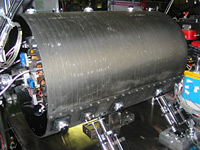 |
|||||||||||
|
|||||||||||
|
|||||||||||
|
The International Linear Collider (ILC) interaction region beam sizes and component position stability requirements will be as small as a few nanometers. Making a head-on collision with a few nanometers beams, each beam travelling across some 20 km in the linear accelerator, is a bit like colliding two baseballs -- one thrown from earth and the other from Saturn! It is important for the ongoing ILC design effort to demonstrate that these tolerances can be achieved -- ideally using a beam-based stability measurement. It has been estimated that an RF cavity beam position monitor (BPM) could provide a position measurement resolution of less than a nanometer. Such BPMs could form the basis of the desired beam-based stability measurement in addition to being used for other specialized purposes. The NanoBPM Collaboration -- of which the Lawrence Livermore National Laboratory is a participating institution -- is developing and testing high resolution RF cavity BPMs. Three prototype BPMs have been installed in the extraction line of the KEK Accelerator Test Facility (ATF) for testing with its ultra-low emittance electron beam. In a system developed at LLNL, the three BPMs are held rigidly with respect to one another in an alignment frame. Each BPM is mounted by six variable-length struts which allow precise movement in both position and angle whilst preserving rigidity. This precise movability is crucial for calibration. The alignment frame in turn is supported by four variable length legs which allow the entire experiment to be steered to the beam to ensure the BPMs stay within their dynamic range. To date, we have been able to demonstrate a resolution of approximately 20 nm over a dynamic range of 40 microns. Most recently, during the first half of January 2006, a metrology system was installed surrounding the existing alignment frame. Also developed at LLNL, this system uses laser interferometry to precisely monitor the positions of the three BPMs relative to a carbon fiber tube with a coefficient of thermal expansion of zero. Initial, preliminary results suggest this metrology system can resolve rigid body motion at the level of approximately 5 nm. -- Sean Walston and Youhei Morita |
|||||||||||
| © International Linear Collider |
